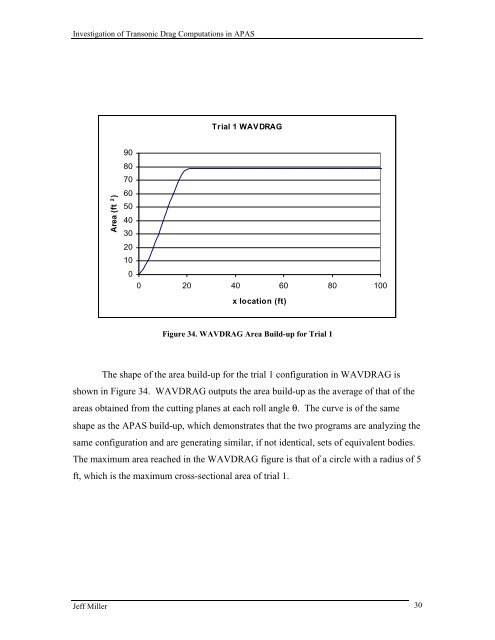Investigation of Transonic Drag Computations in Aerodynamic ...
Investigation of Transonic Drag Computations in Aerodynamic ...
Investigation of Transonic Drag Computations in Aerodynamic ...
Create successful ePaper yourself
Turn your PDF publications into a flip-book with our unique Google optimized e-Paper software.
<strong>Investigation</strong> <strong>of</strong> <strong>Transonic</strong> <strong>Drag</strong> <strong>Computations</strong> <strong>in</strong> APAS<br />
Trial 1 WAVDRAG<br />
Area (ft 2 )<br />
90<br />
80<br />
70<br />
60<br />
50<br />
40<br />
30<br />
20<br />
10<br />
0<br />
0 20 40 60 80 100<br />
x location (ft)<br />
Figure 34. WAVDRAG Area Build-up for Trial 1<br />
The shape <strong>of</strong> the area build-up for the trial 1 configuration <strong>in</strong> WAVDRAG is<br />
shown <strong>in</strong> Figure 34. WAVDRAG outputs the area build-up as the average <strong>of</strong> that <strong>of</strong> the<br />
areas obta<strong>in</strong>ed from the cutt<strong>in</strong>g planes at each roll angle θ. The curve is <strong>of</strong> the same<br />
shape as the APAS build-up, which demonstrates that the two programs are analyz<strong>in</strong>g the<br />
same configuration and are generat<strong>in</strong>g similar, if not identical, sets <strong>of</strong> equivalent bodies.<br />
The maximum area reached <strong>in</strong> the WAVDRAG figure is that <strong>of</strong> a circle with a radius <strong>of</strong> 5<br />
ft, which is the maximum cross-sectional area <strong>of</strong> trial 1.<br />
Jeff Miller 30
















